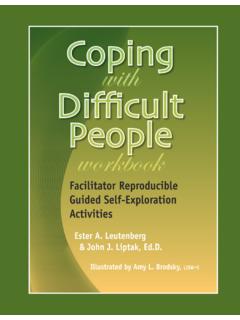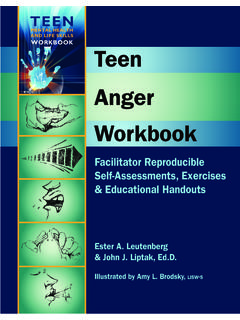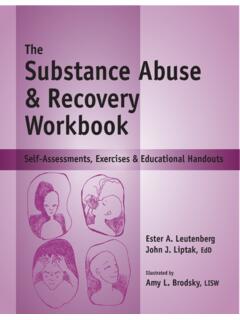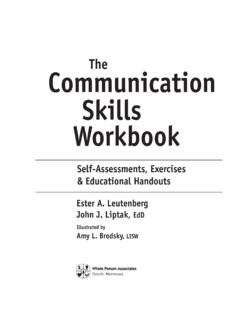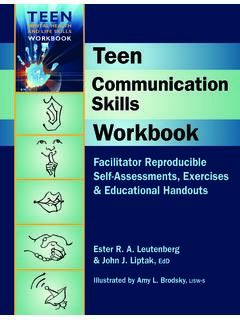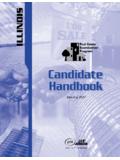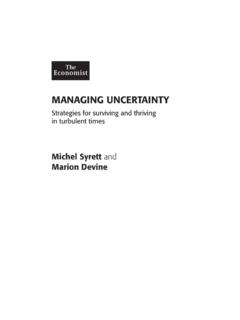Transcription of managing moods Managing Moods Workbook for Teens …
1 I 2014 Whole Person AssociAtes, 101 W. 2nd St., Suite 203, Duluth MN 55802 800-247-6789 IntroductionA Toolbox of RepRoducible AssessmenTs and AcTiviTies for FAciliTAToRs Managing moodsWorkbook for TeensEster R. A. Leutenbergand John J. Liptak, EdDduluth, MinnesotaErasingMEntal illnEssthroughawarEnEssthEofA Toolbox of RepRoducible AssessmenTs and AcTiviTies for FAciliTAToRsEster R. A. Leutenbergand John J. Liptak, EdDManaging Moods Workbookfor Te e n sErasingMEntal hEalth issuEsthroughawarEnEssthEofCopyrighted Material Purchase at 2014 Whole Person AssociAtes, 101 W. 2nd St., Suite 203, Duluth MN 55802 800-247-6789 Managing Moods Workbook for Teens101 W. 2nd St., Suite 203 Duluth, MN www Moods Workbook for Teens A Toolbox of Reproducible Assessments and ActivitiesCopyright 2014 by Ester R. A. Leutenberg and John J. Liptak.
2 All rights reserved. Except for short excerpts for review purposes and materials in the assessment, journaling activities, and educational handouts sections, no part of this book may be reproduced or transmitted in any form by any means, electronic or mechanical without permission in writing from the publisher. Self-assessments, exercises, and educational handouts are meant to be photocopied. All efforts have been made to ensure accuracy of the information contained in this book as of the date published. The author(s) and the publisher expressly disclaim responsibility for any adverse effects arising from the use or application of the information contained Printed in the United States of America10 9 8 7 6 5 4 3 2 1 Editorial Director: Carlene Sippola Art Director: Joy Morgan DeyLibrary of Congress Control Number: 2014909596 ISBN: 978-1-57025-320-1 Copyrighted Material Purchase at 2014 Whole Person AssociAtes, 101 W.
3 2nd St., Suite 203, Duluth MN 55802 800-247-6789 Introductionusing the Managing Moods Workbook for TeensTeen years can be extremely difficult, even in the best of circumstances. During these years emotions can be intense, and changes in mood occur very rapidly. Adolescence is a time of not only great emotional turmoil, but also sudden mood swings and increasing rebelliousness. It is important for Teens to be aware of when they are responding typically to stressful life circumstances or when they are experiencing excessive moodiness that seems to be taking over their lives. Teens tend to be very emotional. Some of these feelings will be positive. On the other hand, some may also be negative and bring forth feelings of sadness, restlessness and irritability. It is usual to feel these types of negative feelings every now and then, but when these moody feelings last for weeks, months, or even years, it is a sign of a more serious mood issue.
4 When Teens find themselves taking little joy in activities they have previously enjoyed, appearing increasingly more irritable, and feeling fatigue and a general loss of energy, they may be experiencing symptoms of more serious problems that require assessment and treatment by a medical professional. Serious mental health issues can stretch far beyond the usual limits of disappointment, loss, frustration, and joylessness. mood problems can be accompanied by an inability to cope with everyday life issues and stressors. Rather than temporary feelings of down in the dumps, these extreme feelings tend to last for more than a few hours or days and tend to affect all aspects of a teen s life, leaving the teen feeling empty, unable to function as usual, and possibly hopeless for weeks, months, and who experience problems in maintaining a balanced and healthy overall mood are often incapable of functioning well in daily life.
5 They frequently experience extreme emotional states, negative feelings, and self-defeating Moods inconsistent with what is happening in their environment. Teens struggling with this mental condition find that they are unable to conquer their moodiness with family members, with family and friends, at school and in their community. Teens experiencing moodiness have problems in interpersonal relationships, ability to study and concentrate, and in the ways they eat, sleep, relax, and live their daily lives. Their real potential is greatly Other Ways Does a mood Management Issue Manifest Itself?For Teens , moodiness manifests itself in a wide variety of ways. It is critical to be aware of, understand, and be cognizant of how these symptoms are commonly seen in Teens . Although all symptoms to do not have to be present, those that are will typically cause significant distress and/or impairment in daily functioning:Our goal for this Workbook is NOT to diagnose a mental illness, or even for the facilitator to make that diagnosis from this book s content.
6 Please see page x for further Poor school performance Irritability Argumentative/angry outbursts at home and in the communityAntisocial behavior Running away from home Theft and vandalism Unsafe sexual behavior Secretiveness Inability to think, focus, or make decisionsLoss of interest in activities and/or peopleProblems exaggerated or imaginary Self-mutilation Preoccupation with death and/or suicidePhysical complaints excessive/exaggeratedAlcohol/illegal drug use Withdrawal Bullying Picking fights Weight gain/weight loss Feelings of worthlessness Loss of appetite Pronounced fears and phobias Family Upheaval Fatigue Copyrighted Material Purchase at 2014 Whole Person AssociAtes, 101 W. 2nd St., Suite 203, Duluth MN 55802 800-247-6789 Managing Moods Workbook for TeensTypes of serious mood inconsistenciesDifferent types of mood disturbances are conveyed and expressed in different forms and include:MAJOR DEPRESSION (often referred to as unipolar depression) involves a profoundly sad mood and a high probability of distorted depressive thinking that occur over time.
7 Some of the additional symptoms:A persistent, sad mood most of the day accompanied by feeling empty Experiencing a significant reduction in appetite and weight loss when not dieting, or increased appetite and weight gainHypersomnia (sleeping too much) or insomnia (an inability to sleep) Feelings of inadequacy Racing thoughts and impulsive behaviors Hostility or aggression Feelings of agitation or feelings of restlessness Fatigue, loss of energy or feelings of being slowed down Feelings of worthlessness and hopelessness or excessive or inappropriate guilt Diminished ability to think or concentrate, remember things or be decisive Constant feelings of anxiety or feelings of irritability Loss of interest in activities, or a decrease in pleasure in activities once enjoyed Physical symptoms such as headaches, pain, digestive problems Thoughts of suicide and/or causing danger to others BIPOLAR DEPRESSION involves an alteration (like a roller-coaster ride) of down feelings (depression) and up feelings (excessive and often inappropriate euphoric), rapid speech and hyperactivity.
8 Some additional symptoms:Cycles of elation and depression Distinct periods of abnormally and persistently elevated and euphoric mood Inflated self-esteem or grandiosity Decrease in the need for sleep Flight of ideas Distractibility Increased engagement in risky behavior MILDER FORMS OF DEPRESSION carry detectable symptoms and impact daily activities in ways that demonstrate a diminished interest in things people usually find interesting or enjoyable. Some of these types of mood disturbances:Dysthymia Person has a mild depression that lingers for more than two years. For people with dysthymia, life has little pleasure. They tend to be cranky, irritable, and Depression Person experiences depression after childbirth. Sometimes called baby blues, this type of depression may be associated with psychological and physical Affective Disorder Person experiences depression with seasonal changes in climate and FROM UNKNOWN ORIGIN includes feelings of sadness and emptiness, low energy, and a lack of interest that occurs naturally when experiencing change or stress in life.
9 Unlike the feelings of sadness and moodiness that are part of everyday life, many people are often unable to deal with their feelings of sadness and moodiness and their feelings last much longer. The mood is accompanied by feelings of irritability and hostility, a growing sense of fatigue, and a sense of hopelessness about the Material Purchase at 2014 Whole Person AssociAtes, 101 W. 2nd St., Suite 203, Duluth MN 55802 800-247-6789 Introductionsources of serious mood inconsistenciesWhere do disturbances in mood originate? Why do some Teens experience changes in mood and moodiness, while others do not? That is not an easy question to answer. Because mood inconsistencies are very complex in nature, they usually do not originate from one source. Rather, many things can lead to mood disturbances in Teens , and often it is not only one of the following sources, but a combination of several ThinkingDistorted, maladaptive, and irrational thinking can cause and enhance feelings of sadness and moodiness.
10 A thorough examination should be conducted by a medical professional to assess Teens thought processes as they relate to and affect and BiologyFamily history can influence one s predisposition to moodiness. Similarly, changes in Teens bodies including fluctuating hormones associated with puberty can be a factor. A complete medical and psychological history should be collected by a medical professional to identify family members who may also have experienced mood SituationsSituations in which people find themselves unable to control outcomes can enhance feelings of anxiety, sadness, a loss of interest, and a sense of hopelessness and helplessness. An examination of the situations in which Teens experience feelings of moodiness should be conducted by a medical professional. Life EventsAn inability to cope with major stressors can be a factor in moodiness.
